Robots Rebooted

2017 lies behind us, and as we send off the best year of Modern, possibly ever, I’m going to take a look at updating an old favourite – Affinity.
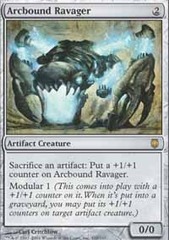
Whilst Affinity has been around since the dawn of Modern, there’s always room for innovation and response to a format in flux. Grand Prix Oklahoma City really showed off the new state of the format, with an evolution away from Modern’s former Boogeyman in Grixis Death’s Shadow and a strong showing from the big mana decks in Tron and Titanshift. With a reduction in the popularity of Stubborn Denial there has also been a surge in the popularity of Cryptic Command, alongside Geist of Saint Traft in Jeskai Control or Gideon of the Trials in U/W.
So where does this leave Affinity? From my standpoint, very slightly improved. Grixis Death’s Shadow is an horrendous match up for Affinity due to the presence of Fatal Push and Kologhan’s Command, making it extremely difficult to keep a Steel Overseer, Master of Etherium or Cranial Plating on board, as well as neutering the Modular trigger from Arcbound Ravager. With GDS going down and Jund being suppressed by Tron, Kologhan’s Command is taking up a much smaller slice of the pie than before, giving Affinity’s uninteractive draws a better success rate. In addition, Tron and Titanshift have relatively few interactive elements and struggle to turn the corner until turn 4 at the earliest (Scapeshift/Oblivion Stone), which is too slow to survive a lot of Affinity draws, making them typically good matchups.
Jeskai and U/W control however are exactly the kind of decks we’re looking to avoid. Putting aside the copies of Stony Silence that typically hang out in the sideboard, these decks contain piles of removal and enough counterspells to keep your payoff cards off the table as you move into the mid-to-late game. These matchups have only gotten worse in recent times thanks to the printing of Ceremonious Rejection, which in tandem with Snapcaster Mage gives the blue decks of the format another avenue of cheap interaction to keep the robots off balance.
So how best to adapt Ol’ Faithful to rise to the challenge? The deck has a number of flex slots and options, and I’m going to break down a few of the possible innovations:
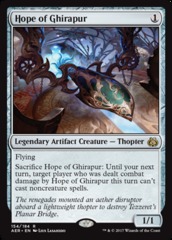
This one has been around for a little while, and I’m pretty surprised it hasn’t been more widely adopted. Swapping one copy of Vault Skirge for a Hope of Ghirapur offers a lot of flexibility to buy time against the combo decks of the format. Specifically, keeping U/R Storm or Titanshift from casting their powerful sorceries for a turn is usually enough to end the game. It helps even more in the post-board games, suppressing Anger of the Gods, Sweltering Suns, Shattering Spree and Shatterstorm. The percentage points you stand to lose in Aggro matchups by missing out on the lifelink are pretty few and far between too – Vault Skirge doesn’t terribly frequently go positive on life, once you’ve accounted for the Phyrexian mana cost.
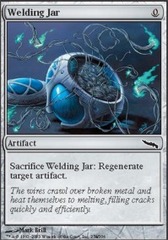
With Lightning Bolt also on the rise, Welding Jar is an easy auto-include from my perspective. Much like Memnite/Ornithopter, Jar adds explosiveness in the opening turns by enabling Mox Opal more frequently, whilst simultaneously protecting Master of Etherium and Steel Overseer. Keeping either of these on the board for more than a turn will usually create an insurmountable advantage. To top it off, you’re safer to move all-in with a Ravager play in the face of potential removal. I’d be wary of overloading on this effect as there are serious diminishing returns in drawing too many versus your actual payoffs, but a single copy does just fine.
Etched Champion vs Master of Etherium
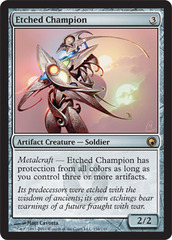
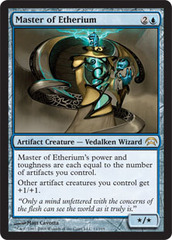
Balancing the numbers of these two cards in your main deck is going to be a deciding factor for a lot of matches. As things stand, I don’t much like Champion in game 1 – whilst very powerful against the Fatal Push and Path to Exile decks, it’s a complete blank against Tron, and gets mown down by Valakut triggers all the same. With a lot of combo floating about thanks to the rise of Storm, I like having the fastest clock possible. Even against combo decks that can stall the board e.g. Company, the anthem effect from Master pumping your fliers more than pays off the inclusion. Pay close attention to your expected metagame and shift back to Master if Kologhan’s Command and friends start to crop back up.
Sideboard Slots
Affinity has always been an oddball deck for its sideboard, as with the typical 12 sources of any colour (plus the typical 1 of Mountain, you have the option to play virtually whatever you want. The usual starting place is a pair of Ancient Grudges and of Ghirapur Aether Grids, but beyond that the world’s your oyster. Some options to consider:
- Eidolon of Rhetoric is a knockout blow against Storm (and incidental hate for Jund Living End), as they have mostly dropped Echoing Truth in favour of more artifact removal and copies of Empty the Warrens.
- Thoughtseize and Spell Pierce fight for the same interaction slots against Combo, with the option to bring them in against Control. In general, I prefer to lean on discard effects at present, as Spell Pierce doesn’t play well against Mana heavy hands out of Storm or the top end of Titanshift. In addition, Affinity can usually make good use of all of its mana in the first four-ish turns of the game to leverage damage – holding up Spell Pierce can leave you with wasted mana over multiple turns if your opponent doesn’t lean into it.
- Company has been on the uptick lately and has a quick clock, lots of redundancy and plenty of ground blockers. Depending on how much of this deck (plus Elves and a couple of others) you’re expecting, you may want to reach for a Whipflare and one or two copies of Dispatch to clear the path and keep your opponent off combo for just long enough.
- Graveyard hate is usually covered by either Relic of Progenitus or Grafdigger’s Cage. As things currently stand, I prefer the Cage as it does a better job of suppressing Dredge, a deck looking to tick up in popularity thanks to favourable match ups against the Control and Tron decks. Sticking a Cage alongside a Welding Jar gives insulation against flashback on Ancient Grudge, demanding your opponent to find two copies by naturally drawing before they can even get their engine going. If Blue Living End starts to turn up in paper, instead opt for Rest in Peace.
- Because the hate for artifacts in Modern is so powerful, other decks are going to improve more than you after sideboard. Post-board affinity can go so far as being non-functional in the face of Stony Silence etc, so in some matchups you just need Blood Moon in the hope of making their deck non-functional. In this way, it’s something of an anti-hate hate card (with extra applications vs Tron/Valakut etc). I’d recommend you spare two slots, but be careful you don’t overboard with them in reducing your artifact count too low.
I’ve barely scratched the surface of the possible here – anything from Glint-Nest Crane to Hazoret the Fervent and anything in between. Given everything that’s been said, I’d play the list below.
| Affinity | |
| Main Deck (60) | |
| Creatures (26): | Lands (17): |
| 2 Memnite | 4 Blinkmoth Nexus |
| 4 Ornithopter | 4 Inkmoth Nexus |
| 4 Signal Pest | 4 Spire of Industry |
| 3 Vault Skirge | 4 Darksteel Citadel |
| 1 Hope of Ghirapur | 1 Mountain |
| 4 Arcbound Ravager | |
| 4 Steel Overseer | Sideboard (15) |
| 4 Master of Etherium | 2 Ghirapur Aether Grid |
| 2 Ancient Grudge | |
| Artifacts (13): | 1 Dispatch |
| 4 Mox Opal | 1 Grafdigger’s Cage |
| 4 Springleaf Drum | 3 Etched Champion |
| 4 Cranial Plating | 1 Eidolon of Rhetoric |
| 1 Welding Jar | 1 Whipflare |
| 2 Thoughtseize | |
| Spells (4): | 2 Blood Moon |
| 4 Galvanic Blast |
Thanks for reading – let me know if you’ve been crushing (or getting crushed!) by any new tech!





